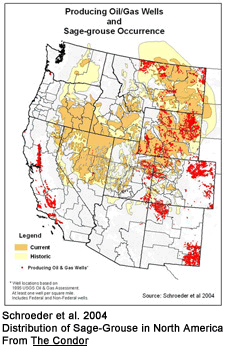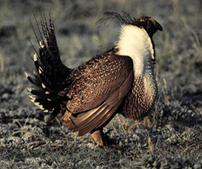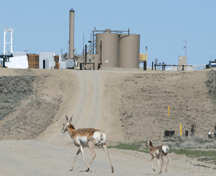Species of Special Concern
 Sage Grouse Sage Grouse
After intense debate and law suits, the U.S. Fish and Wildlife Service announced in November 2014 that it would list the Gunnison Sage Grouse as a threatened species. Energy development as well as housing and associated roads have impacted the habitat of the species. For an in-depth look at sage grouse species, habitat requirements, and landscape management for sage grouse see the plans of the Western Association of Fish and Wildlife Agencies, individual state agencies, and collaborative working groups. Resources on these links discuss effects of oil and gas development on grouse, strategies and practices for habitat management within oil and gas fields, and monitoring practices.
Western Association of Fish and Wildlife
Greater Sage-Grouse Comprehensive Conservation Strategy - The Greater Sage-Grouse Comprehensive Conservation Strategy was signed in 2007 to maintain and enhance populations and distributions of sage-grouse. This document outlines the strategies and plans to conserve Greater Sage-Grouse in certain regions of North America.
Colorado
Greater and Gunnison Sage Grouse Conservation Plans
Both the Gunnison and Greater Sage Grouse are on the Bureau of Land Management State Director's sensitive species list. The website provides information on both species and their conservation.
Wyoming
Wyoming Sagebrush/Sage Grouse Management (Wyoming Game and Fish Department) - The Wyoming Game and Fish Department provides licenses and resources for hunting and fishing. This webpage provides links to Sage-Grouse conservation plans, guides, core area maps, and other documents related to Sage-Grouse conservation in Wyoming.
Sage Grouse Management (Petroleum Association of Wyoming) - The Petroleum Association of Wyoming (PAW) and its member companies have established the PAW Sage-grouse Management Team dedicated to proactively addressing issues affecting sage-grouse in Wyoming. The team—comprised of members ranging from wildlife biologists to reclamation specialists—strives to be the resource for industry education and participation related to sage-grouse. This link provides a list of Best Management Practices covering a variety of topics e.g. reclamation, habitat mapping, and monitoring.
Greater sage-grouse population response to natural gas field development in western Wyoming - A PhD Dissertation by M.J. Holloran, on the Greater sage-grouse population response to natural gas field development in western Wyoming. The study predicted that sage grouse populations would become extinct in the Pinedale Anticline and Jonah development fields within 19 years if current population trends continue.
Sage Grouse Winter Habitat Selection and Energy Development in the Powder River Basin: Completion Report - The recent surge in coal-bed natural gas development has resulted in rapid and large-scale changes to sagebrush habitats in the Powder River Basin of Montana and Wyoming without a complete understanding of its potential impacts to wildlife populations. This report explains research done by the University of Montana on winter habitat use in the Powder River Basin.
Sage-grouse Population Response to Coal-bed Natural Gas Development in the Powder River Basin: Interim Progress Report on Region-wide Lek-count Analyses - In this interim progress report, the authors from the University of Montana report preliminary results from an analysis of region-wide lek-count data for greater sage-grouse from the Powder River Basin in relation to coal-bed natural gas development. This progress report explains the first of four separate analyses of these data.
 Biodiversity Conservation Alliance - Additional Sage Grouse Studies - The Biodiversity Conservation Alliance provides four links to Biodiversity Conservation Alliance - Additional Sage Grouse Studies - The Biodiversity Conservation Alliance provides four links to
different reports on Sage-Grouse recovery and response due to
natural gas development.
Western North America
Adaptive management of prairie grouse: How do we get there?
Development in Western North America: Effects on Sagebrush Steppe Avifauna with Particular Emphasis on Sage-grouse
Threatened and Endangered Species
The Endangered Species Act (ESA) is a powerful federal law that regulates management of threatened and endangered wildlife species through critical habitat designations and strict controls on activities that could cause harm to protected species. The U.S. Fish and Wildlife Service administers the ESA as it applies to both private and public entities, but state wildlife agencies play a cooperative role in the listing and management of threatened and endangered species. For background information on the ESA, see the Red Lodge Clearinghouse Website: LAWS: Endangered Species Act.
State Species of Concern
States also designate species of state concern and develop management strategies for those species to prevent a need for federal listing as threatened or endangered. See the following links for information on state species of concern.
Colorado
Colorado Division of Wildlife, Species of Concern
Colorado Natural Heritage Program - The Colorado Natural Heritage Program is Colorado’s only comprehensive source of information on the status and location of Colorado’s rarest and most threatened species and plant communities.
Montana
Montana Fish, Wildlife and Parks - Species of Interest - The mission of Montana Fish, Wildlife & Parks is to provide for the stewardship of the fish, wildlife, parks, and recreational resources of Montana, while contributing to the quality of life for present and future generations. This page of their website provides definitions for species types such as endangered, threatened, controlled, and non-controlled.
Montana Natural Heritage Program - The Natural Heritage Program provides information on Montana's species and habitats, emphasizing those of conservation concern.
New Mexico
New Mexico Wildlife Conservation - Species of Concern (BISON-M) - The mission of the New Mexico Department of Game & Fish is to conserve, regulate, propagate and protect the wildlife and fish within the state of New Mexico using a flexible management system that ensures sustainable use for public food supply, recreation and safety; and to provide for off-highway motor vehicle recreation that recognizes cultural, historic, and resource values while ensuring public safety. The Conservation page of their website provides information on New Mexico’s invasive species & diseases, wildlife species, and wildlife damage management.
Oil and Gas Development Guidelines, Conserving New Mexico’s Wildlife Habitats and Wildlife - The purpose of this publication is to provide a set of guidelines that are broadly useful to guide oil and gas development statewide. These guidelines are intended to promote attention to conserving wildlife and habitat while continuing to develop energy resources.
Natural Heritage New Mexico - Natural Heritage New Mexico (NHNM) does research on the conservation and sustainable management of New Mexico’s biodiversity. NHNM does biology research and education in the context of conservation and climate change.
Utah
Utah Conservation Data Center - The Utah Conservation Data Center is the central repository for Utah biodiversity information. They focus primarily on Utah’s rare native spices and other high-interest species (game animals and raptors, for example).
Wyoming
Wyoming Natural Diversity Database - The Wyoming Natural Diversity Database of the University of Wyoming offers the most complete source of data for species and vegetation communities of conservation concern in Wyoming.
|
What Do We Know?
State wildlife agencies, academics, industry and conservation groups all want to understand the impact of development – including oil and gas development – on wildlife populations. Many entities are sponsoring and participating in research projects and wildlife monitoring efforts throughout the Intermountain West. The following are links to agency web sites and to a small sampling of that research. Please help us bring more of this research to our web site community. Click the ABOUT US button to contribute information for this section.
General
Research and Publications, Our Public Lands, National Wildlife Federation - Provides links to reports, scientific studies, brochures, etc. pertaining to the protection of public lands. This website is a place for hunters, anglers and other outdoor enthusiasts to get information about public lands.
Sportsmen For Responsible Energy Development - Sportsmen For Responsible Energy Development is a coalition of businesses, organizations, and individuals seeking to ensure that oil and gas industry interests are balanced against the need to protect the air, water, wildlife, and way of life in the Rocky Mountain West.
Recommendations for Responsible Oil and Gas Development & The Sportsmen For Responsible Energy Development Bill of Rights - In May 2008, experienced land managers, scientists, planners and fish and wildlife experts created a framework for implementing responsible energy development across the West. This report is the product of that unprecedented event and outlines sportsmen’s recommendations for oil and gas development that provide for our energy needs without sacrificing our Western heritage.
Colorado
Colorado Parks & Wildlife -Research
Literature Review of Oil and Natural Gas Development Impacts on Prairie Grouse
Montana
Montana Division of Fish, Wildlife, and Parks - The mission of Montana Fish, Wildlife & Parks is to provide for the stewardship of the fish, wildlife, parks, and recreational resources of Montana, while contributing to the quality of life for present and future generations. Their website provides information on topics such as habitats, hunting and fishing licenses and regulations, and outdoor safety.
Montana Comprehensive Wildlife Strategy - The Comprehensive Fish and Wildlife Conservation Strategy was developed through the collaboration and hard work of many Fish, Wildlife & Parks employees along with numerous agencies, organizations, and the public throughout Montana. This document is a comprehensive assessment of Montana's fish and wildlife and the places they inhabit.
New Mexico
New Mexico Game and Fish
Conservation webpage - The New Mexico Wildlife Conservation page includes reports on various issues such as invasive species and diseases, threatened and endangered species, and bighorn sheep biology and management.
Habitat Fragmentation and the Effects of Roads on Wildlife and Habitats - This document is intended for use as a resource to assist in assessing the potential impacts of roads and highways on terrestrial and aquatic habitats, species, and ecosystem processes.
Utah
Great Basin Research Center - The Utah Division of Wildlife Resources' Great Basin Research Center, located in Ephraim, Utah, conducts forest and rangeland restoration research needed to implement effective wildlife habitat conservation programs statewide. The primary objective is to develop the Division's capability to restore poor-condition big game winter ranges. The Great Basin Research Center conducts germination trials and cultivation studies on Native Plant Program species.
Wyoming
Wyoming Game and Fish Department
Wyoming Game and Fish Department Homepage - The Wyoming Game and Fish Department provides licenses and resources for hunting and fishing.
Wyoming Wildlife and Habitat Information - This page of the Wyoming Game and Fish Department website provides links to topics pertaining to wildlife and habitat information. These topics include possessing wildlife, fish, wildlife technical information, and law enforcement.
Recommendations for Development of Oil and Gas Resources within Important Wildlife Habitats (v6, April 2010) - This document, by the Wyoming Game and Fish Commission, provides recommendations to ameliorate conflicts between oil and gas development and wildlife resources.
Wyoming Landscape Conservation Initiative - The Wyoming Landscape Conservation Initiative is a long-term science based effort to assess and enhance aquatic and terrestrial habitats at a landscape scale in southwest Wyoming, while facilitating responsible development through local collaboration and partnerships.
Wyoming Wildlife Federation: Oil and Gas Development Research and Publications - The Wyoming Wildlife Federation works for hunters, anglers, and other wildlife enthusiasts to protect and enhance habitat, to perpetuate quality hunting and fishing, to protect citizens' right to use public lands and waters, and to promote ethical hunting and fishing.
Western Ecosystems Technology Incorporated (WEST Inc). is a private environmental consulting company that performs development impact studies, primarily in Wyoming, for both the federal government and private industry. See their Reports and Publications page for relevant research on big game and oil and gas development.
Big Game Species
Effects of Roads on Elk: Implications for Management in Forested Ecosystems - This paper describes research on the effects of roads on elk.
Wyoming Pronghorn Working Group - The Wyoming Game and Fish Department provides licenses and resources for hunting and fishing. This webpage provides resources for aerial line transect sampling for estimating pronghorn abundance.
Western Association of Fish and Wildlife Agencies Mule Deer Working Group: Mule Deer in the West - Changing Landscapes Changing Perspectives - The Western Association of Fish and Wildlife Agencies is a leader in promoting management and protection of fish and wildlife in the western United States and Canada. Mule deer numbers and distribution have been declining throughout the West since the latter third of the 20th century. To address this concern, the Mule Deer Working Group was established in 1998. This publication sheds light on the single greatest factor that has caused declines in mule deer—loss and degradation of habitat.
Migratory Birds & Other Wildlife
The U.S. Fish & Wildlife Service estimates that 500,000 to 1 million birds are lost every year in pits used in the exploration and production of oil and gas. The following video, produced by the Fish & Wildlife Service in 2012, looks at the risks to birds and other wildlife at oil and gas facilities and the best management practices that can be used to prevent this mortality.
Lesser Prairie Chickens and Wild Turkey
Ecology and Management of the Lesser Prairie Chicken - This document, written by the Division of Agricultural Sciences and Natural Resources at Oklahoma State University, addresses the concerns associated with the loss of habitat due to the conversion of prairies and scrublands to cropland, introduced pasture, and development and its effect on the Lesser Prairie-Chicken.
The Relationship of Rio Grande Wild Turkey Distributions to Roads - This document reports on a study done by Texas Tech University College of Agricultural Science and Natural Resources on the effect roads have on the distribution of Rio Grande wild turkey.
Grizzly Bear
Analysis of Road Densities in Selected Grizzly Bear Management Units in the Northern Rockies - As roadless lands decrease, secure habitat for grizzly bears and other wildlife species sensitive to roads decreases as well. Due to this issue, an analysis, known as the "Roads Scholar Project," by the Ecology Center and the Predator Project combined aerial photo and map inventories with field surveys and GIS, to identify, assess, analyze, and display the current conditions of roaded wildlife habitat in selected management units in Montana, northern Idaho, eastern Washington, and northwestern Wyoming.
Review of Oil and Gas Exploitation Impacts on Grizzly Bears - This is a review of literature from the University of Montana on the impact of exploration and development on grizzly bears.
Fish
Wild Fish Habitat Initiative - The Wild Fish Habitat Initiative offers links to studies of different types of fish species such as an, “Evaluation of Habitat Restoration for the Fluvial Arctic Grayling in the Bighole River, Montana,” and “Thermal Requirements of Westslope Cutthroat Trout.”
Effects of Coalbed Methane Development on Great Plains Fish Assemblages - This study from Montana State University was conducted to better understand the influence of coalbed methane development on the aquatic biota and habitats of southeast Montana and northeast Wyoming. The research team’s specific objective was to determine the effect of coalbed methane development on intermittent prairie stream fish assemblages.
|

 Sage Grouse
Sage Grouse Biodiversity Conservation Alliance -
Biodiversity Conservation Alliance -
